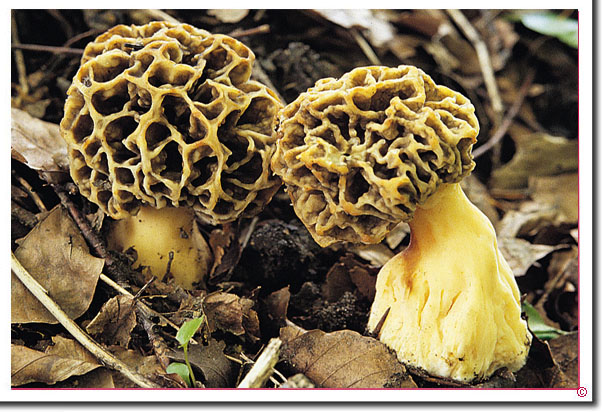weiß bis
cremeweiß
Verwandtschaft:
Ständerpilze
. Ascomycetes .
Schlauchpilze
. Pezizales .
Becherlingsverwandte
. Morchellaceae .
Hier behandelte Arten:
Morchella conica .
Spitzmorchel
Morchella elata .
Hohe Morchel
Morchella esculenta .
Speisemorchel
Morchella semilibera .
Käppchenmorchel
Beitrag zu Morcheln
aus Tintling 37 (Heft 4/2003)
Literatur zur
Gattung Morchella
bei Amazon
Morcheln - Morchella

Gattungstypus ist die Speise-Morchel Morchella esculenta Foto: Fredi Kasparek
Gattungsmerkmale:
Fruchtkörper mit hohlem Stiel und hohlem Kopf, 3 - 30 cm hoch und 1,5 - 10 cm breit. Hymenium wabenförmig, gelbm grau oder braun in verschieden Nuancen und Abstufungen. Stieloberfläche weißlich bis bräunlich, längsgrubig, warzig.
Sporen hyalin bis blass gelblich, ellipsoid, glatt, einzellig, 17 - 30 x 11 - 18 µm, oft mit kleinen apikalen Tropfen, inamyloid, uniseriat. Asci zylindrisch, 240 - 450 x 17 - 28 µm, 8-sporig, J-. operculat. Paraphysen hyalin bis gelblich, häufig verzweigt und septiert, apikal leicht keulig verdickt, 8 - 20 µm.
Mykorrhiza bildend oder saprob; terrestrisch und auf Holzschnitzeln im Frühjahr wachsend.
Wichtige Literatur:
Boudier, M.E. (1905 - 1911): Icones Mycologicae Des Champignons De France Principalement Discomicètes, Avec Texte Descriptif. 5 Volumes.
Breitenbach, J. & Kränzlin, F. (1981. Pilze der Schweiz Band 1. Ascomyceten.
Eriksson O.E. et al (2001): Outline of Ascomycota Myconet Bd. 7 ISSN 1403-1418
Häffner, J. (1994): Die Gattung Morchella. Auswertung unterschiedlicher Artkonzeptionen - Rhein.-Pfälz. Pilzj. 4: 46-59.
Imler, E.J. (1968): Unsere Morcheln.
Jacquetant, E. (1984): Les morilles. Lausanne, 114 pp.
Kreisel, H. (1997): Morchella vaporaria Brondeau, die Stickmuster-Morchel - ein Pilz ruderaler Standorte - Boletus 21 (1): 27-32.
Mayr, R. 1982): Untersuchungen zum Wachstum und zur Entwicklung einiger Arten der mycorrhizabildenden Gattung Morchella. Dissertation zur Erlangung des Doktorgrades der Naturwissenschften, Universität Giessen, Deutschland.
McFarlane, E.M., Pilz, D. & Weber, N.S. (2005): High-elevation gray morels and other Morchella species harvested as non-timber forest products in Idaho and Montana - Mycologist 19 (2): 62 - 68.
Miller, S.L., Torres, P. & McClean, T.M. (1994): Persistence of basidiospores and sclerotia of ectomycorrhizal fungi and Morchella in soil - Mycologia 86 (1): 89 - 95.
Maas Geesteranus, R.A. (1967): De fungi van Nederland 2a. Peziales. u.a. Helvellaceae, Morchellaceae) - Wet. Med. Kon. Nederl. Nat. Vere. 69: 1-72 (30 - 35
O’Donnell, K., Cigelnik, E., Weber, N.S. & Trappe, J.M. (1997): Phylogenetic relationships among ascomycetous truffles and the true and false morels inferred from 18S and 28S ribosomal DNA sequence analyses - Mycologia 89(1): 46-65.
Ower, R. (1982): Notes on the development of the morel ascocarp: Morchella esculenta - Mycologia 74: 142-144.
Persoon, C. H. (1794): Neuer Versuch einer systematischen Eintheilung der Schwämme - Römers Neues Magazin für der Botanik 1: 63-128.
Röger F. (2003): Morcheln - Kostbarkeiten im Frühlingswald. Tintling 4/2003
Wipf, D., Koschinsky, S., Clowez, P., Munch, J.C., Botton, B. & Buscot, F. 1997. Recent advances in ecology and systematics of morels - Cryptog., Mycol. 18 (2). 95 - 109.
Yoon, C.-S., Gessner, R.L. & Romano, M.A. (1990): Population genetics and systematics of the Morchella esculenta complex - Mycologia 82 (2): 227 - 235.


Gattungstypus ist die Speise-Morchel Morchella esculenta Foto: Fredi Kasparek
Gattungsmerkmale:
Fruchtkörper mit hohlem Stiel und hohlem Kopf, 3 - 30 cm hoch und 1,5 - 10 cm breit. Hymenium wabenförmig, gelbm grau oder braun in verschieden Nuancen und Abstufungen. Stieloberfläche weißlich bis bräunlich, längsgrubig, warzig.
Sporen hyalin bis blass gelblich, ellipsoid, glatt, einzellig, 17 - 30 x 11 - 18 µm, oft mit kleinen apikalen Tropfen, inamyloid, uniseriat. Asci zylindrisch, 240 - 450 x 17 - 28 µm, 8-sporig, J-. operculat. Paraphysen hyalin bis gelblich, häufig verzweigt und septiert, apikal leicht keulig verdickt, 8 - 20 µm.
Mykorrhiza bildend oder saprob; terrestrisch und auf Holzschnitzeln im Frühjahr wachsend.
Wichtige Literatur:
Boudier, M.E. (1905 - 1911): Icones Mycologicae Des Champignons De France Principalement Discomicètes, Avec Texte Descriptif. 5 Volumes.
Breitenbach, J. & Kränzlin, F. (1981. Pilze der Schweiz Band 1. Ascomyceten.
Eriksson O.E. et al (2001): Outline of Ascomycota Myconet Bd. 7 ISSN 1403-1418
Häffner, J. (1994): Die Gattung Morchella. Auswertung unterschiedlicher Artkonzeptionen - Rhein.-Pfälz. Pilzj. 4: 46-59.
Imler, E.J. (1968): Unsere Morcheln.
Jacquetant, E. (1984): Les morilles. Lausanne, 114 pp.
Kreisel, H. (1997): Morchella vaporaria Brondeau, die Stickmuster-Morchel - ein Pilz ruderaler Standorte - Boletus 21 (1): 27-32.
Mayr, R. 1982): Untersuchungen zum Wachstum und zur Entwicklung einiger Arten der mycorrhizabildenden Gattung Morchella. Dissertation zur Erlangung des Doktorgrades der Naturwissenschften, Universität Giessen, Deutschland.
McFarlane, E.M., Pilz, D. & Weber, N.S. (2005): High-elevation gray morels and other Morchella species harvested as non-timber forest products in Idaho and Montana - Mycologist 19 (2): 62 - 68.
Miller, S.L., Torres, P. & McClean, T.M. (1994): Persistence of basidiospores and sclerotia of ectomycorrhizal fungi and Morchella in soil - Mycologia 86 (1): 89 - 95.
Maas Geesteranus, R.A. (1967): De fungi van Nederland 2a. Peziales. u.a. Helvellaceae, Morchellaceae) - Wet. Med. Kon. Nederl. Nat. Vere. 69: 1-72 (30 - 35
O’Donnell, K., Cigelnik, E., Weber, N.S. & Trappe, J.M. (1997): Phylogenetic relationships among ascomycetous truffles and the true and false morels inferred from 18S and 28S ribosomal DNA sequence analyses - Mycologia 89(1): 46-65.
Ower, R. (1982): Notes on the development of the morel ascocarp: Morchella esculenta - Mycologia 74: 142-144.
Persoon, C. H. (1794): Neuer Versuch einer systematischen Eintheilung der Schwämme - Römers Neues Magazin für der Botanik 1: 63-128.
Röger F. (2003): Morcheln - Kostbarkeiten im Frühlingswald. Tintling 4/2003
Wipf, D., Koschinsky, S., Clowez, P., Munch, J.C., Botton, B. & Buscot, F. 1997. Recent advances in ecology and systematics of morels - Cryptog., Mycol. 18 (2). 95 - 109.
Yoon, C.-S., Gessner, R.L. & Romano, M.A. (1990): Population genetics and systematics of the Morchella esculenta complex - Mycologia 82 (2): 227 - 235.
